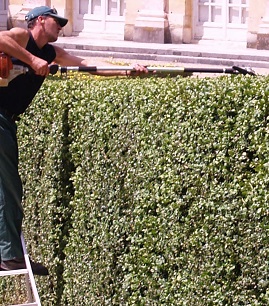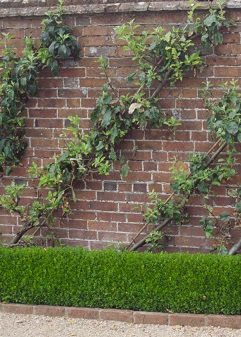Sneak Peek
LEARN TO PRUNE PLANTS - Understand How Plant Growth and Pruning are Linked.
Become a "Certified Pruner"
Pruning is one of the fundamental skills needed by gardeners and
horticulturalists. However, it is much more involved than merely cutting
off plant growth. There are many different reasons to prune, and there
are many different ways to go about pruning.
What to prune, when to prune, how to prune and why we prune - all these questions can be answered through this short course. For the professional horticulturist to the home gardener, understanding the science and technique of pruning will allow you to support and enhance the growth of plants and improve fruit and flower production.
This short course provides instruction on how to prune range of ornamental
plants as well as important species like fruits and roses. Students
will learn how to assess the pruning needs of plants and learn about
good pruning practices. Furthermore, you’ll learn how to encourage
fruiting and flowering, how to create topiary and espaliers, and how to
make bonsai. Upon completion you will feel confident in your knowledge
of how and when to prune all sorts of plants.
Lessons

There are nine lessons as follows:
Lesson 1: Introduction
- Why, when and what to prune: How pruning affects plants
- Removing broken branches, dead or diseased wood
- Controlling the type of growth
- Controlling the plant’s shape and size
- Promoting healthy, bushy growth
- Rejuvenating a plant
- Why prune?
- Pruning different species
- Timing for pruning
- What is compartmentalisation?
Lesson 2: Types of Pruning
- Cleaning out dead wood
- Stopping
- Disbudding
- Deadheading
- Pollarding
- Removing branches
- Crown cleaning
- Crown thinning
- Crown reduction
- Crown lifting
- Crown renewal
- Root pruning
- Pruning trees in general
- Pruning larger shrubs
- Pruning tropical plants
- Pruning container plants
Lesson 3: Pruning Tools and Equipment
- Secateurs
- Pruning knife
- Loppers
- Pole pruners
- Hand saws
- Trimmers
- Chainsaws
- Gloves
Lesson 4: Pruning Hedges
- Selecting hedging plants
- Establishing a hedge
- Types of hedge
- Pruning or trimming an established hedge
- Rejuvenating old and overgrown hedges
- Pruning conifers
- Other hedging techniques
- Pleaching
- Tapestry hedges
- Mazes
Lesson 5: Shaping Plants
- How to develop an espalier
- Horizontal espalier
- Oblique palmette espalier
- Topiary
- Portable topiary
- Other plants suitable for topiary
- Single-stem topiary
- Verdant sculptures
- Bonsai
- Creating bonsai
- Pruning bonsai to shape it
Lesson 6: Managing Prunings
- Composting waste
- Choosing plants for composting
- Using compost to improve soils
- Composting in home gardens
- Indore method
- Using lawn clippings
- Mulching
- How to lay mulch
- Biochar
- Chipping
Lesson 7: Pruning for Fruit Production
- Before buying plants consider the shape
- Before pruning
- Points to consider when pruning
- Pruning specific fruits
- Citrus spp.
- Pruning a bush shape
- Pruning a standard shape
- Renovating an old citrus tree
- Open vase shape formative pruning
- Plum tree pruning
- Pruning apricots
- Knowing your buds
Lesson 8: Pruning Roses
- When to prune roses
- Pruning techniques for different types of roses
- Pruning climbers and ramblers at a glance
- Pruning roses as standards
- Dead heading roses
- Rejuvenating an old rose plant
Lesson 9: Compendium of Plants - How to Prune What and When
- Summary: Basic pruning guide
- Glossary
Pruning is a skill that every gardener needs to master - from home gardener to tradesman to professional.
LEARN HOW AND WHY TO WE PRUNE?
 There are lots of different reasons and ways of pruning. Here are some:
There are lots of different reasons and ways of pruning. Here are some:
Cleaning Out Dead Wood
It is important to remove dead tissue from your plants regularly. This will improve both their appearance and health. Infections (e.g. bacteria, fungal diseases and even insects) attack and gain a foothold in dead or weakened plant tissues with relative ease. Once established, they are able to multiply and spread much more easily into the healthy parts of the plants. Regular pruning can thus be a major way of controlling diseases in plants.
Any dead or rotting plant material still attached to a plant acts as a possible source of infection because it offers a weak point for entry of diseases. As such, it should be removed from the plant and removed form your garden.
Stopping
Stopping (also known as tip-pruning or pinching) is a system of pruning that encourages bushy growth. As we've already seen, when a plant produces apical growth (known as apical dominance) it is because energy is concentrated in a single tip bud and the buds along the stem remain dormant. If the apical tip is removed the buds lower down will start to produce side-shoots. Some plants such as bedding plants usually only need to be tip pruned once whereas shrubby plants will produce very bushy growth and prolific blooms by repeated stopping. Stopping is also a way of diverting energy into fruit crops in plants such as grapes. When doing this, you must think about how much growth you will be stimulating at the end of the branch. You must not leave too much bare stem that will not only look unsightly, but which will not be able to support the flush of new growth.
Disbudding
This method of pruning involves removing the side or lateral buds as soon as they appear. This serves to focus energy in the terminal (top) bud. It reduces the amount of blooms allowing the remaining blooms to become larger and is a method that is particularly used for roses and camellias.
This method is also used to prevent crowding of stems in plants such as chrysanthemums and to direct extra energy to root development. You may also be doing it if you are growing tomatoes in a glasshouse.
Deadheading
Some plants drop their flowers while they’re still fresh whereas others hold on to the spent flowers for weeks, or even months. Deadheading, the action of cutting off dead flowers, is beneficial for garden plants for the following reasons:
When you cut off the dead flowers, you are cutting off dead tissue which could be harbouring diseases or attract pathogens.
The pruning cuts encourage side shoots to grow so the plant will produce more flowers.
You are removing unsightly withered flowers and improving the plant’s appearance.
By removing the flowers you are preventing seeds (and fruits) developing - so the plant has more energy for growth and further flower production.
Most flowering plants will benefit from deadheading including: annuals, herbaceous perennials, many flowering bulbs, roses, daisies (including their relatives such as dahlias and chrysanthemums), hydrangeas (leave the final flower heads through the winter months), azaleas, camellias and rhododendrons. The more frequent the deadheading the better because it encourages more flowers and can reduce the risk of disease.
Pollarding
Pollarding is a means of managing trees from an early age. It is carried out to obtain a short ornamental stem and maintain a small crown. The initial crown reduction forms a permanent framework. This is followed by regular (often annual) pruning. The main branches are cut back almost to the main trunk using secateurs or a sharp saw. Growth of thin, new branches is encouraged. Pollarding is commonly used in Europe to maintain the shape of street trees such as lime trees (Tilia species).

Who is this Course intended for?
- Home gardeners who want to do a lot better in their gardens
- Anyone starting up or wanting to expand the range of services
offered in a garden business (e.g. a lawn mowing business, seeking to
offer an expanded service. When mowing work declines in winter, you can
have another source of income, pruning roses and fruit trees)
- Anyone seeking employment as a gardener. This course can give
you knowledge and skill that sets you apart and gives an employer a
reason to consider you above other applicants
- Garden managers seeking to train their staff
- Gardeners, nurserymen, landscapers or horticulturists wanting to fill in a gap in their skills set.
Features
- Enrol any time of day or night
- Start studying immediately or later (as you wish)
- Configure your study sessions at any length and frequency you wish
- Work through at your own pace
- Automated
self assessment tests pop up at the end of each lesson. You can attempt
these as many times as you wish; and each time, upon completion, you
can see your results.
- At the end of the whole course, you are
presented with a major automated examination which can be attempted
online, anywhere, any time.
- If you achieve a 60% pass in the final exam, you immediately receive a downloadable 'Certificate of Completion'.
How does this course work?
You can enrol at any time
Once you have paid for the course, you will be able to start straight away.
Study when and where you like. Work through at your own pace.
You can download your study-guide to your smart phone, tablet or laptop to read offline.
There are automated self-assessment tests you can complete at the end of each lesson. You can attempt these as many times as you wish and each time, upon completion, you can see your results. You will need internet access to complete the self assessment tests.
At the end of the course, you are presented with a large assessment which can be attempted online, anywhere, anytime. If you achieve a 60% pass in the exam; you immediately receive a downloadable certificate of completion with your name on it. If you do not achieve a 60% pass rate, you can contact us to re-sit your exam. ( email- admin@acs.edu.au )
Contact us at anytime if you have any issues with the course. admin@acs.edu.au